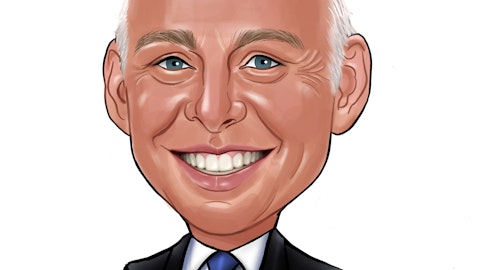Frank Schiraldi: Curious on the – Brian, on the fee income guide. So I think, yes, you said a flat rate environment as far as the NII guide. Just curious what the driver is of the fee income growth. If we do see rates down, does that imply some growth in mortgage banking, or is that sort of on the come if we do have lower rates – in the rate cuts in the back half of the year?
Brian Richardson: Yes. So there’s a couple of components that play into that. Of course, in our insurance and wealth businesses, we expect kind of mid to high single-digit to low double-digit growth in those businesses in a stable environment. And on the mortgage banking side, we do expect some level of increase. While production is expected to be less year-over-year, we have a larger focus on saleable production, which will generate more gain on sale income and benefit the non-interest income line.
Frank Schiraldi: Okay. But the driver is more outside of the mortgage banking, I guess, in terms of the growth year-over-year, it sounds like.
Brian Richardson: The mortgage is a component of it, but it’s the kind of the diversified businesses that we have. All of them will be contributors to the growth.
Frank Schiraldi: Okay. And then can you – I’m sorry, if I missed just in terms of – it sounds like the core NIM is approaching stabilization. I don’t know if you said, do you expect to get there in early 2024, but also just curious about reported NIM if you – if maybe that takes a little bit longer to inflect in terms of do you assume some continued build the liquidity here, maybe as long growth is a little bit more measured in the near term?
Brian Richardson: No I think both – again, this is Brian, Frank. I think both of those will continue to move in line with each other we – as we kind of see some runoff of public funds and the like. I would actually expect that excess liquidity to diminish in the near term and kind of reported and core will start to converge as well. But I do expect both of those to bottom out in the first half of the year and then see increases thereafter.
Frank Schiraldi: Okay. And then just – you mentioned the variable rate piece of the loan book that will reprice immediately. If you can just maybe talk a little bit about the longer duration book, the Cree book, is it fair to just basically assume 20% reprices a year? And just curious what the pickup in rates you’re seeing currently in terms of that renewal.
Brian Richardson: Yes, I mean, we’ve definitely seen a slowdown. I would say, historically 20% to 25% would have been a reasonable kind of churn number. We see that slowing down a little bit in the current environment in the back half of 2023, but somewhere in that 15% to 20% range is what you could reasonably expect there. And as far as rates, our current commercial portfolio yield is just below 6%. It’s at 593. For the fourth quarter, commercial production kind of core production was at 770, and that now was up 20 basis points, 25 basis points from last quarter. So again, there’s an opportunity there as all those assets reprice, and there is churn. You get lift there as well.
Frank Schiraldi: Okay, great. And then if I could just sneak in one last one just on, I’m not sure if I didn’t see it, maybe it’s somewhere in the release. But in terms of loan modifications that you are making or have made on the rate or term side, do you guys disclose that? And just curious, what sort of level of modifications you guys have made on the rate side in the Cree book?
Brian Richardson: We disclose it in our 10-Q and 10-K in our loan footnote. It will be ultimately disclosed there, but I will say there has not been substantial modifications, rate, or structure that would be included in that disclosure.
Frank Schiraldi: Okay, great. I appreciate the color. Thanks.
Jeffrey Schweitzer: Thank you.
Brian Richardson: Thank you, Frank.
Operator: [Operator Instructions] Our next question today comes from Matthew Breese from Stephens Inc. Your line is now open. Please go ahead.
Matthew Breese: Hi, good morning. I was hoping we could just first start with where we are in the municipal deposit cycle and how much that played a role in the deposit dynamics this quarter.
Mike Keim: So, Matt, when you say, where – it’s Mike, where we are on the cycle, if you’re thinking for fourth quarter that – the end of the third quarter, very early part of the fourth quarter is the peak of the municipal deposits for us traditionally. And you start to see a small kind of ramp down in the fourth quarter. That gradual ramp down continues in the first quarter, and then you get more pronounced by the end of the second quarter, and then it resets itself. What we’ve done is be able to work with some county and other municipalities to kind of fill in to reduce that peak and valley. But when you look at our financials, especially in the September, the third quarter end, that’s really like peak municipal deposits we want to have on our balance sheet going forward.
Matthew Breese: Got you. Okay.
Brian Richardson: Matt, just put some numbers around that. Sorry, Matt, this is Brian. At 9/30, we were at $1.433 billion of public funds, that would decrease by $165 million in the fourth quarter. And we’d expect that to kind of continue to wind down through the second quarter, then see that rebuild next year in it.



